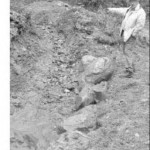It looked a bit like chocolate milk as it merged with the clear water of the larger creek, rushing down to the string of lakes in the valley far below, but the milkiness quickly dissipated as it was absorbed.
Muddy runoff into a tributary stream from road work can be dealt with by dilution in larger streams, before that water reaches a community water intake—as long as it’s just one or two instances.
But if there are hundreds of little brown streams flowing in, muddy water comes out of people’s taps.
“It becomes a really big deal. They add up,” explains Jack Allingham, manager of utilities for the District of Lake Country.
He was pointing out one spot in the community’s watershed where clouded water was running into the district’s water source this week.
During Tuesday’s tour of the Oyama Lake watershed, which supplies about 25 per cent of the community’s water, representatives from the forest ministry’s range division, B.C. Timber Sales, Tolko Industries, and Lake Country staff and politicians were shown a recent clearcut, a salvage timber operation and discussed potential problems and possible ways to solve them.
Allingham pointed out that the cleaner your source water is, the less costly treatment of it is, so it’s important to protect watersheds.
Okanagan watersheds are all multi-use, from industrial activity such as logging and cattle range, to recreational uses such as fishing, motor biking and mud bogging.
All can impact water quality.
Lake Country Mayor James Baker says in the last few years BCTS has worked with the district to reduce, wherever possible, the impact of logging activities in the watershed, including re-routing a section of the Oyama Lake Forest Service Road.
That avoided this historic crossing of a small seasonal stream which then carried the muddied water into a tributary of Oyama Creek and ultimately into the district’s water intake.
However, this week road grading is again creating muddy runoff into that little seasonal creek, which now goes through a culvert under the road, into the clear stream.
Allingham pointed out the silt fencing and hay bales used to prevent silt from getting into the creek, but it’s found a new way around the obstruction.
He says this is 1,000 times better than it was before the road improvements.
Turbidity from tributaries is a very important cause of degraded water quality at the intake, so every time an improvement can be implemented, it’s a big plus for the water utility responsible for providing potable water out of the tap.
Water utilities are reluctant to spend taxpayer money on expensive water filtration plants, particularly when often a large percentage of it goes to grow crops.
However, Interior Health is encouraging water utilities in the Okanagan to move to filtration if their source is surface water rather than groundwater.
Dave Gill, BCTS planning officer, says sedimentation is the biggest issue, but when dirt is exposed, for instance by building roads or logging, it moves, often in water and into streams.
Road networks are probably the biggest causes of watershed sediment, adds Brian Bedard, planning forester for BCTS.
They also open up the watershed to recreational users, he notes.
There’s 140 km of roads in Lake Country’s watershed.
Who has the responsibility for maintenance is another thorny issue.
Gill explains that industry builds the roads, but once they’ve completed logging in an area, the roads revert to the forests ministry to maintain.
That’s why many now are deactivated so no one can use them. It’s the cheapest answer to liability and maintenance.
Because this forest road accesses a fishing camp and recreation site, it’s still being maintained by the ministry, even though wilderness recreation is now managed under the Ministry of Tourism, Culture and the Arts.
In the past few years, logging in the Oyama Lake area has focussed on salvaging timber that’s been killed by mountain pine beetle.
That’s been done now, and there’s no logging activity going on currently, Gill says.
It’s logged out for the present. In the future, it’s expected they’ll go back in and begin to log some spruce and balsam, but there’s not a market willing to pay in today’s economic climate.
Tolko is logging to salvage beetle-attacked pine on the other side of the Oyama watershed, but it’s not a money-making venture with global prices as low as they are, explains the Tolko representative.

